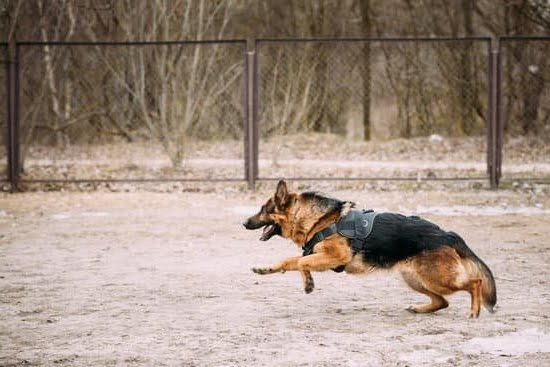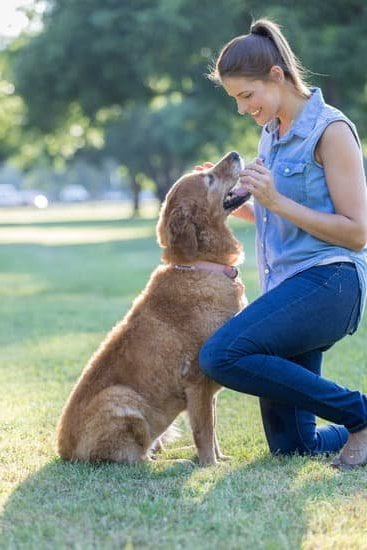Are you tired of your dog constantly pulling on the leash during walks? If so, then learning how to train a dog to heel without pulling is essential for both you and your furry companion.
Mastering the heel command not only makes walking more enjoyable but also strengthens the bond between you and your dog. In this article, we will delve into the basics of heeling, understand the reasons behind pulling behavior, and explore effective training methods to help your dog become a well-behaved walker.
Heeling is an important skill in dog training as it teaches your canine companion to walk closely beside you without tugging on the leash. This not only makes walks more pleasant but also ensures better control and safety. By understanding the importance of teaching your dog to heel without pulling, you can establish a strong foundation for obedience and improve overall behavior.
In order to successfully train your dog to heel without pulling, it’s crucial to understand why dogs tend to pull on the leash in the first place. Addressing this behavior requires patience, consistency, and positive reinforcement training techniques. By focusing on these key elements, you can effectively guide your canine friend to master the heel command and enjoy stress-free walks together.
The Basics
Heeling in dog training refers to the practice of teaching a dog to walk closely alongside its owner, matching their pace and stopping when they stop. Mastering this skill is beneficial for both the dog and the owner as it promotes better control, improved communication, and a stronger bond. When a dog consistently heels without pulling, it not only makes walks more enjoyable but also enhances safety for both the pet and the owner.
Understanding your dog’s behavior is crucial in addressing the tendency to pull while walking. Dogs often pull because they are excited, curious, or simply seeking stimulus from their environment. Additionally, many owners unintentionally reinforce pulling behavior by allowing their dog to move forward when they pull on the leash. Recognizing these factors is essential in formulating an effective training approach.
Positive reinforcement training is widely recognized as an effective method for teaching a dog to heel without pulling. This involves rewarding good behavior with treats, praise, or toys to encourage the desired response. Using positive reinforcement helps create a positive association with heeling and motivates the dog to comply willingly.
| Benefit | Description |
|---|---|
| Better control | Heeling promotes better control during walks and other activities. |
| Improved communication | Mastering heeling fosters clearer communication between the owner and the dog. |
| Stronger bond | Practicing heeling without pulling strengthens the bond between the dog and its owner. |
In order to effectively train a dog to heel without pulling using positive reinforcement, it is essential to start with simple exercises such as luring the dog into position and rewarding them once they maintain it for a few seconds. Gradually increasing the duration of heeling while rewarding good behavior will help solidify this skill. Consistency and patience are key when following this step-by-step training process.
Addressing challenges that may arise during training is important for successful outcomes. Common issues include distractions from other animals or people, restlessness during walks, or difficulty maintaining focus. These challenges can be overcome through consistent training sessions in different environments, gradually increasing levels of distraction, and reinforcing good behavior through positive rewards.
By consistently practicing proper training techniques using positive reinforcement, dogs can successfully learn how to heel without pulling. Providing regular opportunities for your pet to practice this skill in various settings will further reinforce good behavior. It’s important for owners to remain patient and committed throughout this process in order to achieve long-term success.
Remember that mastering heeling without pulling requires time, effort, and dedication from both you and your furry companion. With determination and persistence, you can enjoy pleasant walks with your well-behaved canine companion.
Understanding Your Dog’s Behavior
Dogs are naturally curious and energetic animals, which can often lead them to pull while walking on a leash. Understanding the reasons behind this behavior is crucial in effectively addressing it.
One common reason for pulling is that dogs are simply excited to explore their surroundings, which may cause them to become easily distracted and ignore their owner’s commands. Additionally, some dogs may have a strong prey drive or be reacting to environmental stimuli such as other animals or unfamiliar noises.
As dog owners, it is important to recognize the common mistakes made in addressing pulling behavior. One mistake is using corrective tools such as choke chains or prong collars, which can actually create more tension and discomfort for the dog, leading to increased pulling. Another mistake is not being consistent with training or inadvertently reinforcing pulling behavior through inconsistent reactions.
To effectively train a dog to heel without pulling, it is essential to address these behavioral reasons and avoid common mistakes. Positive reinforcement training methods are highly effective in shaping desired behaviors in dogs, including heeling without pulling.
Here are some tips on how to train a dog to heel without pulling:
- Start by teaching your dog a solid “sit” and “stay” command.
- Practice loose leash walking in a low-distraction environment before progressing to busier areas.
- Use high-value treats or rewards to reinforce your dog’s attention and close proximity while walking.
Consistency and patience are key when training your dog to heel without pulling. By understanding your dog’s behavior and avoiding common mistakes, you can effectively teach this important skill while strengthening the bond between you and your furry companion.
Positive Reinforcement Training
Positive reinforcement training is a widely recommended method for teaching a dog to heel without pulling. This approach focuses on rewarding desired behaviors with treats, praise, or other forms of positive reinforcement, rather than punishing unwanted behavior. This method not only fosters a positive and cooperative relationship between you and your dog but also encourages them to repeat the behavior you desire.
When using positive reinforcement to teach your dog the heel command, it’s essential to understand that consistency is key. Every time your dog successfully follows the heel command without pulling, promptly reward them with a treat or verbal praise. Over time, they will associate heeling without pulling with receiving a reward, making it more likely to comply with the command in the future.
Additionally, it’s important to use high-value rewards during training sessions to ensure that your dog is motivated to learn and perform the heel command correctly. High-value treats can be small pieces of cooked chicken or cheese – something that your dog finds particularly irresistible. By using these rewards strategically during training, you can effectively communicate to your dog what behavior you want them to exhibit.
| Key Principles | Details |
|---|---|
| Consistency | Consistently reward your dog each time they successfully follow the heel command without pulling. |
| High-Value Rewards | Use enticing treats such as cooked chicken or cheese as rewards during training sessions. |
Lastly, maintain patience and understanding throughout the training process. Every dog learns at their own pace, so it’s important not to get frustrated if progress seems slow at first. With consistent practice and positive reinforcement, your dog will eventually master the heel command without pulling and enjoy pleasant walks together.
Step-by-Step Training Process
Using Positive Reinforcement
One of the most effective methods for training a dog to heel without pulling is positive reinforcement. This involves rewarding your dog with treats, praise, or other forms of positive feedback when they exhibit the desired behavior. When teaching your dog to heel, it’s important to use high-value treats that your dog finds especially enticing.
This will motivate them to pay attention and stay by your side during walks. Additionally, using verbal praise and physical affection can also reinforce the behavior you want to encourage.
Initial Exercises
To begin training your dog to heel without pulling, start in a quiet and familiar environment with minimal distractions. It’s important for both you and your dog to be relaxed and focused during these initial exercises.
Using a standard leash, position your dog on your left side and hold the leash loosely with your right hand. Use a treat to guide your dog into the proper heeling position, making sure they are walking beside you without pulling on the leash.
Progressions
As your dog becomes more comfortable with the heeling position, gradually introduce more challenging environments and distractions. Practice in different locations such as parks or busy streets, gradually increasing the duration of time spent heeling without pulling.
Consistency is key during this process – be patient and continue reinforcing good behavior with rewards and praise. Over time, your dog will learn to associate staying by your side with positive experiences and will be more likely to heel without pulling in various situations.
By following these steps and remaining consistent in their training efforts, owners can effectively teach their dogs how to heel without pulling while building a strong bond based on trust and clear communication between human and canine companions.
Addressing Challenges
Understanding Common Challenges
During the process of training your dog to heel without pulling, you may encounter various challenges that can hinder progress. Some common issues include your dog getting easily distracted, pulling on the leash, or reverting to old habits. It is important to understand these challenges in order to effectively address them and continue with the training process.
Overcoming Distractions
One of the most common challenges in training a dog to heel without pulling is managing distractions. Dogs are naturally curious and may get easily distracted by other people, animals, or stimulating environments while on a walk. To overcome this challenge, it is essential to gradually expose your dog to distractions in a controlled manner.
Start with low-distraction environments and gradually increase the level of distractions as your dog becomes more proficient at heeling without pulling. Additionally, using high-value treats or rewards can help redirect your dog’s attention back to you when facing distractions.
Dealing With Leash Pulling
Leash pulling is another common issue that owners face when training their dogs to heel. A key step in addressing this challenge is teaching your dog proper leash manners through positive reinforcement. When your dog pulls on the leash, stop walking and wait for them to release tension before continuing forward.
Consistency is crucial in addressing leash pulling – every time your dog pulls, interrupt their behavior and reward them for walking calmly by your side. With patience and consistent training, you can overcome this challenge and teach your dog to walk politely without pulling.
These are just a few examples of the challenges that may arise during the training process of teaching a dog to heel without pulling. By understanding these challenges and implementing effective strategies to address them, you can successfully overcome obstacles and continue making progress in training your dog. Remember that patience, consistency, and positive reinforcement are key components in resolving these issues and achieving success in teaching your furry companion proper heeling behavior.
Now it’s time for reinforcing good behavior.
Consistency and Practice
Training a dog to heel without pulling requires consistency and regular practice sessions. It is important to understand that learning any new behavior takes time, and dogs need regular reinforcement to maintain their training. Consistency in training helps the dog understand what is expected of them and reinforces good behavior.
To start, it’s crucial to set aside time each day for training sessions with your dog. Short but frequent practice sessions are more effective than irregular, long sessions. By incorporating heel training into your daily routine, you are consistently reinforcing the behavior you want from your dog.
Additionally, consistency extends beyond just the training sessions. It also involves maintaining consistent expectations and cues for your dog. This means using the same commands and signals each time you train your dog to heel. Dogs thrive on routine, so keeping things consistent will help them understand what is expected of them.
It’s also important to remember that patience is key when it comes to consistent training. Every dog learns at their own pace, so it’s important not to get frustrated if progress seems slow. With patience and dedication to consistent training, you will see long-term success in teaching your dog to heel without pulling.
Reinforcing Good Behavior
Once you have successfully trained your dog to heel without pulling, it is important to reinforce this behavior in various environments and situations. Consistency is key when it comes to maintaining the heel command, as dogs thrive on routine and clear expectations. Here are some tips on how to reinforce good behavior and ensure that your dog continues to heel without pulling:
- Practice in different environments: Once your dog has mastered heeling in familiar surroundings, gradually introduce them to new environments such as parks, busy streets, and outdoor events. This will help them generalize the behavior and understand that the heel command applies everywhere.
- Use distractions strategically: Introduce controlled distractions during training sessions to teach your dog to maintain focus on you while heeling. Start with mild distractions and gradually increase the level of difficulty as your dog becomes more proficient at ignoring external stimuli.
- Reward consistently: Continue using positive reinforcement techniques such as verbal praise, treats, or toys to reward your dog for heeling correctly. Consistent rewards will reinforce the desired behavior and motivate your dog to continue obeying the heel command.
In addition to reinforcing good behavior in different environments, it is important to practice heeling in various situations that you encounter during daily walks or outings with your dog. By doing so, you can effectively strengthen their understanding of the heel command and ensure that they respond reliably in any context.
- Practice around other dogs: Encountering other dogs while walking can be a common trigger for pulling behavior. Engage in controlled training sessions with other dogs present, using positive reinforcement to teach your dog that heeling is non-negotiable regardless of distractions.
- Work on different surfaces: Dogs may have a tendency to pull more in certain types of terrain, such as grassy areas or pavements. Varying the walking surfaces during training will help your dog learn to maintain a consistent pace and position regardless of the ground beneath their paws.
- Implement real-life scenarios: As part of reinforcing good behavior, simulate real-life scenarios such as approaching doorways or crossing roads while maintaining the heel command. This practical approach will solidify your dog’s understanding of heeling as an essential part of everyday walks.
By consistently reinforcing the heel command in diverse environments and situations, you can build a strong foundation for long-term success and enjoy stress-free walks with a well-behaved canine companion.
Conclusion
In conclusion, training a dog to heel without pulling is not just about obedience and good behavior; it also strengthens the bond and trust between you and your furry companion. By understanding the importance of teaching your dog to heel, you are not only setting clear boundaries and expectations but also fostering a deeper connection based on trust, communication, and mutual respect. This skill can greatly enhance your walks together and make them more enjoyable for both of you.
Throughout this article, we have discussed the basics of heeling, the reasons behind a dog’s pulling behavior, and the principles of positive reinforcement training. We have provided a step-by-step guide on how to train your dog to heel without pulling, as well as tips for addressing challenges that may arise during the process.
Remember that consistency and practice are key in successfully teaching your dog to heel without pulling. With patience, dedication, and positive reinforcement, you can reinforce good behavior in different environments and situations. Ultimately, by investing time in proper training, you are not only shaping your dog’s behavior but also strengthening the bond between you and your canine companion. So keep practicing, stay patient, and enjoy the rewarding experience of walking side by side with your well-trained pup.
Frequently Asked Questions
How Long Does It Take to Train a Dog to Heel?
The time it takes to train a dog to heel can vary depending on the dog’s breed, age, and individual temperament. Some dogs may pick up the skill quickly with consistent training, while others may take longer.
What Is the Heel Trick for Dogs?
The heel trick for dogs is a command that teaches them to walk closely alongside their owner’s leg without pulling on the leash. It requires the dog to pay attention to their owner’s movements and walk in sync with them.
What Side Should a Dog Heel On?
A dog should heel on the left side of their owner. This tradition dates back to when people used horses for transportation, allowing the right hand to be free for greeting or defending oneself. Training a dog to heel on this side provides consistency and safety during walks.

Welcome to the blog! I am a professional dog trainer and have been working with dogs for many years. In this blog, I will be discussing various topics related to dog training, including tips, tricks, and advice. I hope you find this information helpful and informative. Thanks for reading!





